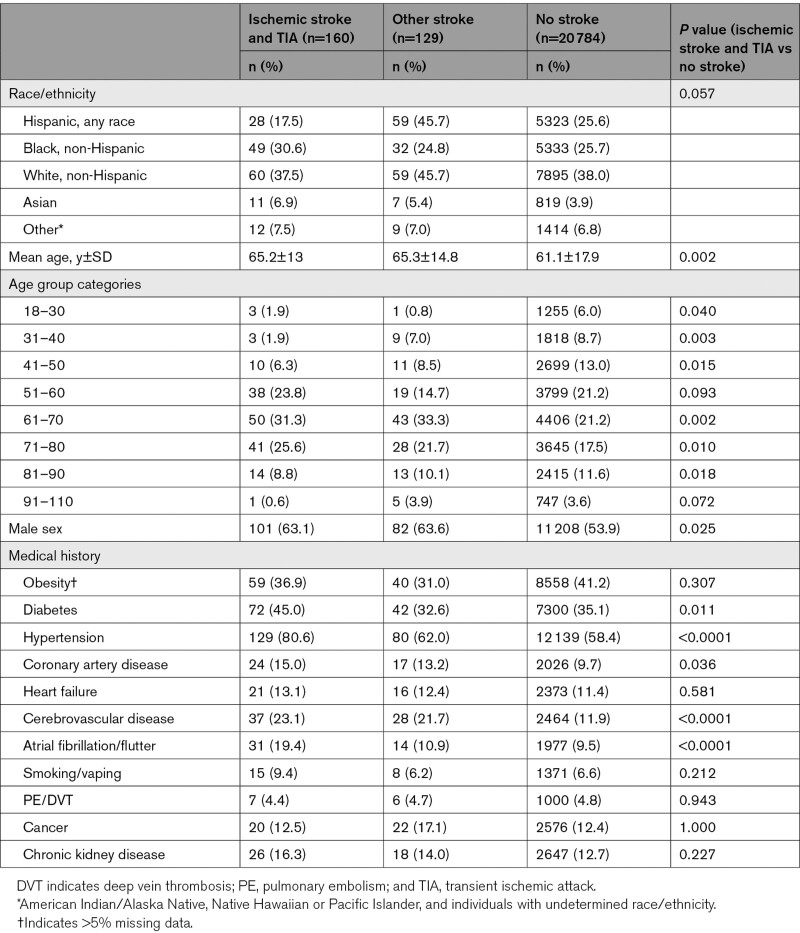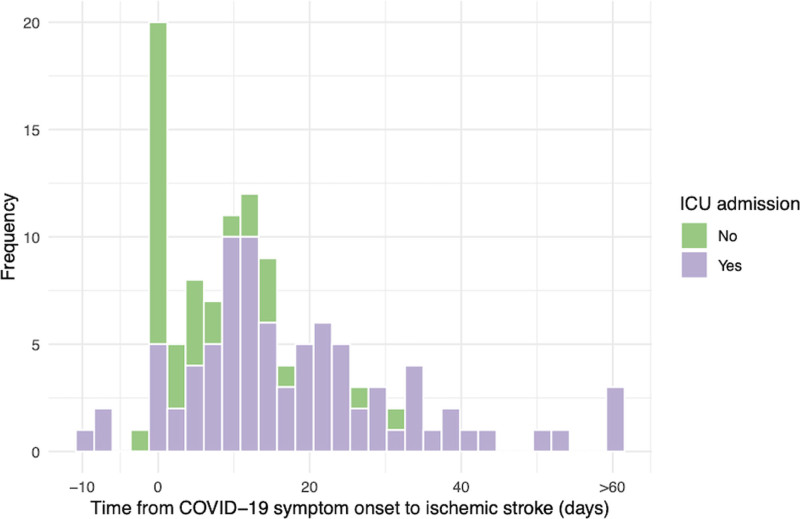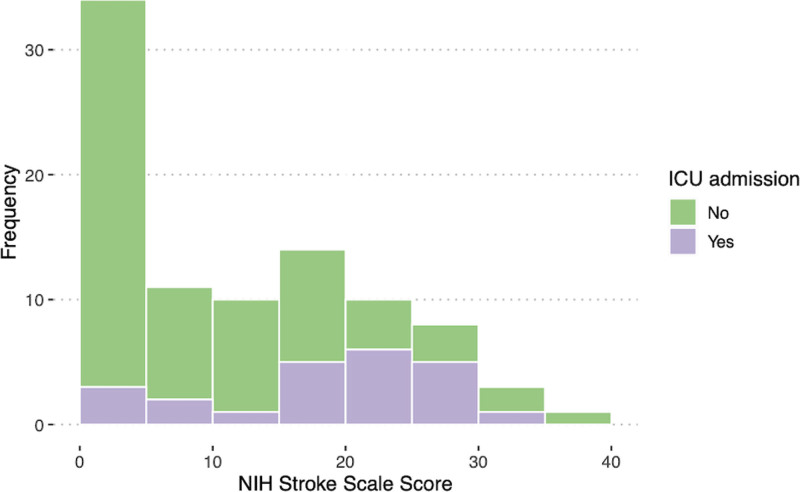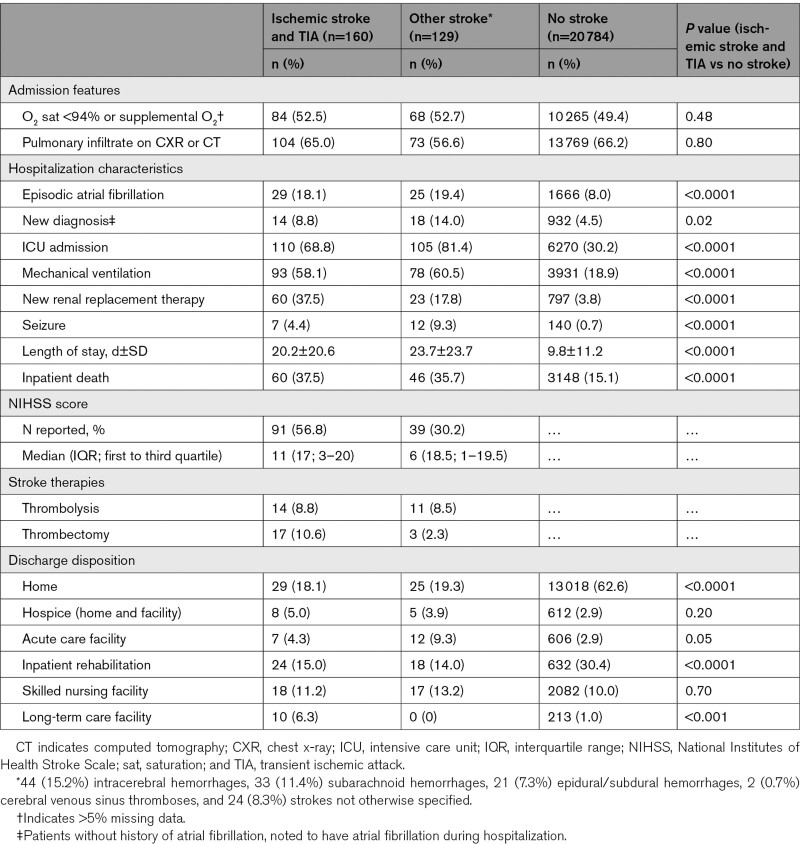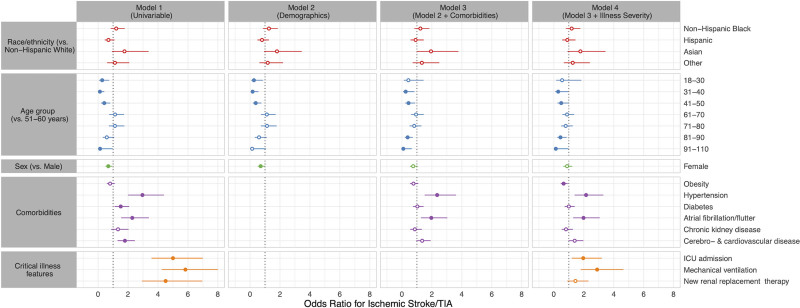Supplemental Digital Content is available in the text.
Keywords: cardiovascular diseases, continental population groups, COVID-19, ethnic groups, ischemic stroke
Background and Purpose:
Coronavirus disease 2019 (COVID-19) may be associated with increased risk for ischemic stroke. We present prevalence and characteristics of strokes in patients with laboratory-confirmed severe acute respiratory syndrome coronavirus-2 infection enrolled in the American Heart Association COVID-19 Cardiovascular Disease Registry.
Methods:
In this quality improvement registry study, we examined demographic, baseline clinical characteristics, and in-hospital outcomes among hospitalized COVID-19 patients. The primary outcomes were ischemic stroke or transient ischemic attack (TIA) and in-hospital death.
Results:
Among 21 073 patients with COVID-19 admitted at 107 hospitals between January 29, 2020, and November 23, 2020, 160 (0.75%) experienced acute ischemic stroke/TIA (55.3% of all acute strokes) and 129 (0.61%) had other types of stroke. Among nonischemic strokes, there were 44 (15.2%) intracerebral hemorrhages, 33 (11.4%) subarachnoid hemorrhages, 21 (7.3%) epidural/subdural hemorrhages, 2 (0.7%) cerebral venous sinus thromboses, and 24 (8.3%) strokes not otherwise classified. Asians and non-Hispanic Blacks were overrepresented among ischemic stroke/TIA patients compared with their overall representation in the registry, but adjusted odds of stroke did not vary by race. Median time from COVID-19 symptom onset to ischemic stroke was 11.5 days (interquartile range, 17.8); median National Institutes of Health Stroke Scale score was 11 (interquartile range, 17). COVID-19 patients with acute ischemic stroke/TIA had higher prevalence of hypertension, diabetes, and atrial fibrillation compared with those without stroke. Intensive care unit admission and mechanical ventilation were associated with higher odds of acute ischemic stroke/TIA, but older age was not a predictor. In adjusted models, acute ischemic stroke/TIA was not associated with in-hospital mortality.
Conclusions:
Ischemic stroke risk did not vary by race. In contrast to the association between older age and death from COVID-19, ischemic stroke risk was the highest among middle-aged adults after adjusting for comorbidities and illness severity, suggesting a potential mechanism for ischemic stroke in COVID-19 independent of age-related atherosclerotic pathways.
The possibility of increased ischemic stroke risk associated with severe acute respiratory syndrome coronavirus 2 infection was first noted among hospitalized patients in Wuhan, China, and shortly thereafter in the United States, when several young patients presented acutely with large-vessel stroke and were later diagnosed with coronavirus disease 2019 (COVID-19).1,2 Subsequent studies observed elevated ischemic stroke risk in COVID-19 compared with similar conditions such as influenza.3 Multiple registry-based studies have demonstrated variable ischemic stroke risk among hospitalized COVID-19 patients ranging from 0.9% to 2.8%.2–6 The largest of these studies included 8163 COVID-19 inpatients across multiple centers in the United States and observed an ischemic stroke risk of 1.3%.6 Outstanding questions remain regarding variable risk for ischemic stroke among COVID-19 patients by race and ethnic group, predictors of stroke, distribution of stroke severity, and outcomes in COVID-19 patients who experience stroke.
In this study, we describe characteristics of hospitalized COVID-19 patients with acute ischemic stroke and transient ischemic attack (TIA) in a large national sample (21 073 patients as of November 23, 2020) from the American Heart Association’s (AHA) COVID-19 cardiovascular disease (CVD) registry.7 Based upon existing literature, we hypothesized that male sex, non-White race, younger age, cardiovascular comorbidities, and COVID-19 severity are risk factors for acute ischemic stroke or TIA among hospitalized patients, after adjusting for other patient-level characteristics.8–10 We also evaluated the impact of acute ischemic stroke or TIA on the risk of in-hospital mortality during a COVID-19 admission.
Methods
Study Design, Data Source, and Population
We conducted a retrospective cohort study using data from the AHA COVID-19 CVD Registry, powered by the Get With The Guidelines quality improvement program.7 The registry was made available free of charge to all US hospitals caring for adults with active COVID-19 and enrolled 21 073 patients from 107 hospitals across the United States from January 29 to November 23, 2020. Strategic outreach has been implemented to recruit both rural and urban US hospitals and thereby develop a diverse and representative registry (Table I in the Supplemental Material; Figure I in the Supplemental Material). Staff at participating sites retrospectively abstracted data in hard-coded fields for all adults (age ≥18 years) hospitalized with severe acute respiratory syndrome coronavirus 2 infection confirmed by laboratory testing. Data abstraction was not considered complete until the patient was discharged from the hospital, with complete data on dates of admission and discharge, age, sex, and medical history. For all hospitals, registry participation was approved or review was waived by a local institutional review board.
Data Collection
The AHA COVID-19 CVD Registry contains over 200 unique data elements. We studied demographics (age, sex, race and ethnicity), comorbidities (obesity, diabetes, hypertension, coronary artery disease, heart failure, prior cerebrovascular disease, atrial fibrillation/flutter, smoking/vaping, deep vein thrombosis/pulmonary embolism, cancer, and chronic kidney disease), admission clinical features (oxygen saturation, pulmonary infiltrates on imaging) and during hospitalization, hospital admission/discharge dates, and disposition. Race and ethnicity of study participants were extracted from site-specific electronic health records and categorized using mutually exclusive categories as follows: Hispanic for all races, non-Hispanic Black, non-Hispanic White, American Indian/Alaska Native, Asian, Native Hawaiian, or Pacific Islander. Hospitalization characteristics included episodic atrial fibrillation, intensive care unit (ICU) admission, mechanical ventilation, new renal replacement therapy, seizure occurrence, length of stay, and inpatient death. Markers of COVID-19 illness severity included ICU admission, mechanical ventilation, and new renal replacement therapy. The intake form for data collection is available at https://www.heart.org/-/media/files/professional/quality-improvement/covid-19-cvd-registry/ahacovidcvdcrf428-fillable-pdf.pdf?la=en. The Get With The Guidelines programs are maintained by the AHA, and IQVIA (Parsippany, NJ) is the data collection and coordination center. We followed the Reporting of Studies Conducted Using Observational Routinely Collected Data Reporting Guideline. Deidentified data from the registry are available through the AHA’s Precision Medicine Platform; requests for access may be made through the AHA COVID-19 CVD Registry at https://www.heart.org/en/professional/quality-improvement/covid-19-cvd-registry/covid-19-cvd-registry-research-opportunities.
Outcomes
The primary outcomes in this analysis were (1) acute ischemic stroke or TIA diagnosis associated with the qualifying COVID-19 hospitalization and (2) in-hospital death. For individuals with multiple admissions, we restricted our analysis to the index admission during which a diagnosis of COVID-19 was made. Secondary stroke-specific outcomes assessed in this study included the initial documented National Institutes of Health Stroke Scale (NIHSS) and acute stroke treatment administered (thrombolysis or thrombectomy). Additionally, baseline and in-hospital characteristics, as well as discharge disposition of ischemic stroke/TIA patients, were compared with COVID-19 patients diagnosed with other stroke subtypes (subarachnoid hemorrhage, intracerebral hemorrhage, epidural or subdural hemorrhage, cerebral venous sinus thrombosis, stroke not otherwise unspecified) and COVID-19 patients without stroke.
Statistical Analyses
We described demographic and baseline clinical characteristics, medical history, and outcomes among patients with acute ischemic stroke or TIA, other stroke subtypes, and no stroke. P values represent 2-sample t tests, χ2 tests, and 2-proportion z tests on continuous, categorical, and binary variables, respectively.
To test our primary hypothesis, we performed sequential multivariable logistic regression analyses to test the strength of association between race/ethnicity and acute ischemic stroke or TIA after incrementally adjusting for demographics, comorbidities, and critical illness features. Given the relatively low event rates, we focused on comparisons between non-Hispanic Black, Hispanic, and Asian patient groups in the registry, with non-Hispanic White patients as the reference category; the remaining patients with ischemic stroke did not have documented race or ethnicity and were classified as such for our analyses. Age was categorized into groups, with 51 to 60 years as the reference category, while males were the reference category for sex. Analyses were performed in RStudio, version 3.6.0 (R Foundation), on the AHA Precision Medicine Platform. Variable missingness was <5% for all variables except body mass index. Multiple imputation with the mice package was used to handle missing data. Parameter estimates from each imputation were pooled to generate CIs and P; P<0.05 was considered statistically significant. Similar analyses were performed to evaluate the association between acute ischemic stroke or TIA and in-hospital mortality.
Results
Characteristics of Hospitalized COVID-19 Patients
Table 1 summarizes demographic and baseline clinical characteristics of patients with acute ischemic stroke/TIA, other stroke, or no stroke. Of 21 073 hospitalized patients with COVID-19, 160 (0.75%) experienced an acute ischemic stroke or TIA confirmed by diagnostic imaging (55.3% of all acute strokes), while a further 129 (0.61%) experienced other types of stroke (Figure II in the Supplemental Material). Among the nonischemic strokes, there were 44 (15.2%) intracerebral hemorrhages, 33 (11.4%) subarachnoid hemorrhages, 21 (7.3%) epidural/subdural hemorrhages, 2 (0.7%) cerebral venous sinus thromboses, and 24 (8.3%) strokes not otherwise classified. Of the 94 (32.5% of all strokes) patients who experienced a documented intracerebral, subarachnoid, or epidural/subdural hemorrhage, 5 (5.3%) had combined hemorrhagic subtypes. Patients with hemorrhagic stroke were 67% male, with a mean age of 62.9±14 years; 83 (88.3%) were managed in the ICU, and 37 (39.4%) died. Mean time from COVID-19 symptom onset to ischemic stroke/TIA was 15.1±16.3 days, while the median was 11.5 days (interquartile range, 17.8; first to third quartile, 4–21.8 days); Figure 1 illustrates a histogram of time to stroke. Five (3.1% of ischemic strokes) patients experienced prehospital acute ischemic stroke/TIA, with the remainder occurring after admission. Patients with COVID-19 and ischemic stroke were, on average, older than COVID-19 patients without stroke. Non-Hispanic Black patients comprised 25.7% of the registry but accounted for 30.6% of ischemic stroke/TIA; Asian patients represented 3.9% of the registry but made up 6.9% of ischemic stroke/TIA. Conversely, Hispanic patients comprised 25.6% of the registry but only 17.5% of ischemic stroke/TIA. Non-Hispanic White patients were similarly represented in the registry and among patients with ischemic stroke (37.5% and 38%, respectively). Prevalence of hypertension, prior cerebrovascular or coronary disease, diabetes, and atrial fibrillation/flutter was higher among patients with COVID-19 and ischemic stroke compared with COVID-19 patients without stroke. Prevalence of obesity and chronic kidney disease did not differ significantly between COVID-19 patients with and without acute ischemic stroke/TIA.
Table 1.
Demographic and Baseline Clinical Characteristics of 21 073 Hospitalized COVID-19 Patients With Acute Ischemic Stroke/TIA, Other Stroke, and No Stroke
Figure 1.
Histogram of days from coronavirus disease 2019 (COVID-19) symptom onset to ischemic stroke/transient ischemic attack for 118 patients for whom data are available. Bars to the left of zero represent individuals who experienced an ischemic stroke immediately before COVID-19 symptom onset. ICU indicates intensive care unit.
Stroke Severity
Figure 2 shows a histogram of NIHSS score in the acute ischemic stroke/TIA cohort (median NIHSS score, 11 [interquartile range, 17; first to third quartile, 3–20]). The majority of strokes occurred in age groups 51 to 80 years, and a significant portion was mild (NIHSS score, ≤5). Of patients with acute ischemic stroke/TIA, 8.8% received thrombolysis and 10.6% underwent thrombectomy (Table 2). Seventy percent of patients with acute ischemic stroke/TIA were managed in the ICU during their admission, compared with 30% of patients who did not experience a stroke; those who were managed in the ICU had higher NIHSS scores (median, 17.5 versus 3). Similarly, 58.1% of patients with acute ischemic stroke/TIA and COVID-19 required mechanical ventilation, compared with 18.9% of patients without stroke.
Figure 2.
Histogram of National Institutes of Health (NIH) Stroke Scale score in 5-unit bins among 91 coronavirus disease 2019 (COVID-19) patients with acute ischemic stroke/transient ischemic attack for whom data are available. ICU indicates intensive care unit.
Table 2.
Admission Features, In-Hospital Characteristics, Interventions, and Outcomes Among 21 073 Hospitalized COVID-19 Patients With Acute Ischemic Stroke/TIA, Other Stroke, and No Stroke
Multivariable Correlates of Acute Ischemic Stroke/TIA Risk
Race and Ethnicity
Acute ischemic stroke prevalence in this registry was 1.3% among Asian patients, 0.91% among Non-Hispanic Black patients, 0.75% among non-Hispanic White patients, and 0.52% among Hispanic patients. Despite these differences in the descriptive analysis, odds of ischemic stroke/TIA did not differ after sequential adjustment for demographics, comorbidities, and illness severity (model 4: odds ratio [OR], 1.77 [0.91–3.45], 1.19 [0.80–1.77], and 0.90 [0.56–1.44], for Asian, non-Hispanic Black, and Hispanic patients, respectively, compared with non-Hispanic White patients). These models are graphically summarized in Figure 3; numerical ORs and 95% CIs are provided in Table II in the Supplemental Material.
Figure 3.
Odds ratios for acute ischemic stroke/transient ischemic attack (TIA) among 21 073 hospitalized coronavirus disease 2019 (COVID-19) patients in sequentially adjusted logistic regression models with reference variables as indicated. CIs at the 95% level are denoted by the horizontal bars; filled circles represent P<0.05. Vertical dotted line represents an odds ratio of 1. ICU indicates intensive care unit.
Sex and Age
We observed a higher proportion of males among COVID-19 patients with acute ischemic stroke/TIA compared with those without stroke (63.1% versus 53.9%, respectively), but sex was not significantly associated with odds of ischemic stroke/TIA in adjusted models. We noted lower odds of ischemic stroke/TIA among age groups younger than 50 years and older than 80 years compared with the reference age category of 51 to 60 years in both unadjusted and adjusted models. Interpretation of these results in the older age groups is limited by the low event rates and potential bias due to higher acuity and mortality. That is, a higher prevalence of critical illness among elderly patients with COVID-19 may have precluded assessment or diagnosis of stroke, or greater mortality among older individuals may have truncated the time required for stroke to occur or be diagnosed. All results are summarized graphically in Figure 3, with point estimates and CIs for ORs provided in Table II in the Supplemental Material.
Comorbidities and Illness Severity
In multivariable adjusted models, hypertension and atrial fibrillation were significantly associated with increased odds of acute ischemic stroke/TIA (model 4: OR, 2.15 [1.39–3.30] and 1.98 [1.29–3.06], respectively), and history of CVD also showed a trend toward positive association (model 4: 1.39 [0.98–1.97]; Figure 3; Table II in the Supplemental Material). As we observed in our descriptive analysis, obesity did not confer an increased risk of ischemic stroke; indeed, after adjusting for comorbidities and illness severity, it was associated with a lower odds of ischemic stroke/TIA (model 4: OR, 0.65 [0.46–0.92]). In the adjusted analysis, only the critical illness features of ICU admission and mechanical ventilation (model 4: OR, 1.96 [1.20–3.20] and 2.89 [1.80–4.64], respectively) were associated with ischemic stroke/TIA.
In-Hospital Outcomes
Episodic atrial fibrillation during hospital admission was more prevalent among COVID-19 patients with acute ischemic stroke than those without stroke (18.1% versus 8%); approximately half in both groups had no history of atrial fibrillation. Length of stay and in-hospital mortality were higher among stroke patients than no-stroke patients (mean length of stay, 20.2±20.6 days for stroke and 9.8±11.2 days for no stroke; mortality, 37.5% for stroke and 15.1% for no stroke; Table 2). COVID-19 patients with acute ischemic stroke/TIA were less likely to be discharged home than those who did not have a stroke (Table 2). In an analysis of predictors of in-hospital mortality among COVID-19 patients, ischemic stroke/TIA was positively associated with inpatient death in the unadjusted analysis, as well as after sequential adjustment for demographics and comorbidities (model 1: OR, 3.33 [2.41–4.59]; model 2: OR, 3.11 [2.14–4.35]; model 3: OR, 3.00 [2.14–4.21]). However, after adjusting for illness severity, ischemic stroke/TIA was not associated with mortality (model 4: OR, 1.19 [0.80–1.77]; Table III in the Supplemental Material).
Discussion
In this study, we present characteristics of hospitalized COVID-19 patients with acute ischemic stroke or TIA in a large, nationally representative registry. While prior studies from the AHA Get With The Guidelines COVID-19 CVD Registry have investigated outcomes and cardiovascular risk factors, this is the first analysis to quantify the prevalence of acute ischemic cerebrovascular events and identify potential predictors of stroke among hospitalized COVID-19 patients in the United States. We noted a higher risk of acute ischemic stroke among patients hospitalized with COVID-19 compared with that reported after influenza or sepsis.2,11 However, compared with other registry-based studies in a similar population, prevalence of acute ischemic stroke in our sample was lower (0.75%). In our sample, more than half the ischemic stroke events occurred within 2 weeks of COVID-19 symptom onset; this aligns with prior findings that ischemic vascular events among COVID-19 patients occur earlier in the infectious course.5 We also noted that COVID-19 patients with ischemic stroke were more likely to be older and male, with a higher prevalence of hypertension, diabetes, and atrial fibrillation, than those without stroke. In addition, COVID-19 patients who experienced an acute ischemic stroke also had higher prevalence of critical illness features and worse in-hospital outcomes. There was no difference in risk of ischemic stroke by race.
Given the racial disparities in infections, hospitalizations, and outcomes throughout the COVID-19 pandemic, we sought to investigate potential disparities in ischemic stroke by race and ethnicity as reported in the registry. Although we noted higher acute ischemic stroke prevalence among hospitalized Asian and non-Hispanic Black COVID-19 patients, in adjusted models, we did not find that odds of ischemic stroke varied by race. However, these findings do not negate the disproportionate impact of the pandemic on communities of color. In an analysis of in-hospital death among Black and White patients with COVID-19 in a large Louisiana-based health system, Price-Haywood et al12 found no differences in mortality after adjusting for sociodemographic and clinical factors. However, Black patients in that study accounted for over 70% of hospitalizations and deaths, despite comprising only 31% of residents in the health system. These findings were also noted in analyses of mortality in this AHA COVID-19 CVD registry, wherein Black and Hispanic patients were overrepresented overall, but mortality did not differ after adjusting for other factors.9 We observed similar discrepancies in prevalence of acute ischemic stroke in our sample. Racial disparities in neurological sequelae specific to COVID-19 remain to be elucidated and should be a focus of future work.
We did not observe in any of our models that older age was significantly associated with higher odds of ischemic stroke; after adjusting for comorbidities and illness severity, age groups younger than 50 years and older than 80 years had a lower risk of ischemic stroke. Although these findings must be interpreted with caution given the small sample of older individuals in our study and potential selection bias, it is remarkable given the generally higher prevalence of atherosclerotic risk factors with increasing age. Despite the relatively long period between COVID-19 symptom onset and stroke occurrence that may have allowed for the development of secondary cardiac complications such as atrial arrhythmias, the majority of acute ischemic cerebrovascular events in the registry are not explained by episodic atrial fibrillation, which occurred in less than a fifth of acute ischemic stroke/TIA patients. A recent study from the AHA Get With The Guidelines Stroke Registry noted younger age among ischemic stroke patients with COVID-19 compared with those who did not have COVID-19, which may suggest a potential nonatherosclerotic pathway associated with the infection underlying ischemic stroke in this population.13 While numerous thrombotic mechanisms have been proposed, the main postulated pathway underlying the burden of thrombotic complications in severe acute respiratory syndrome coronavirus 2 infection is the interaction between intravascular tissue factor, innate immune cells, platelets, and endothelial cells that ultimately activates the coagulation cascade.14 These hypothesis-generating findings suggest a potential prothrombotic pathway unique to COVID-19.
Our finding that ischemic stroke/TIA was not a predictor of in-hospital death after adjusting for illness severity in addition to demographics and comorbidities suggests that the higher mortality among COVID-19 inpatients with ischemic stroke may be driven by COVID-19–associated illness severity rather than ischemic stroke itself. Our main analysis indicated that ICU admission and mechanical ventilation were significantly associated with risk of ischemic stroke/TIA. This suggests that risk of ischemic stroke in COVID-19 may be mediated primarily by the severity of COVID-19 illness, which in turn also confers a higher risk of mortality. These findings are hypothesis generating, however, and we did not investigate in depth the associated morbidity among COVID-19 patients with ischemic stroke, which is an equally important measure of outcome. Although we observed a lower likelihood of discharge to home for COVID-19 patients with acute ischemic stroke compared with those without stroke, further measures are needed to define the burden of morbidity from concomitant COVID-19 and acute ischemic stroke.
Our observational approach has several limitations. Our sample is prone to selection bias, given that individuals with cardiovascular and stroke risk factors and are more likely to be hospitalized for COVID-19 than those without these risk factors; thus, we may have observed a relatively high prevalence of acute ischemic stroke in our inpatient cohort not due to COVID-19 infection but confounding comorbidities. Additionally, some of the predictors of ischemic cerebrovascular events identified in our study may be statistically significant but hold less clinical relevance. We also do not account for potential time-varying covariates, such as hospital capacity and COVID-19 prophylactic and therapeutic strategies, during the surge of cases in the United States in the early months of the pandemic, which may have influenced outcomes following stroke. Further, although we report findings by race/ethnic group, race/ethnicity in this data set is taken from clinical records, and not reliably available via self-report. Finally, given the exclusive enrollment of hospitalized subjects with COVID-19 in our sample, we cannot generalize our findings to nonhospitalized patients. As our outcomes are limited to in-hospital end points, we also cannot infer the long-term cardiovascular risk associated with COVID-19 from the data in our study.
Conclusions
We observed a lower-than-previously-reported prevalence of acute ischemic stroke among patients hospitalized with COVID-19; however, the prevalence was still higher than that reported in association with similar infectious conditions. Individuals who were middle aged, had vascular risk factors, or had greater severity of COVID-19 illness were at higher risk of ischemic stroke. Although acute ischemic stroke prevalence varied by race and ethnic group, these differences were not borne out after adjusting for other comorbid conditions. Ongoing work is needed to understand the mechanism and risk for ischemic stroke among COVID-19 patients, the efficacy of traditional stroke therapies in this population, and the effect of COVID-19 on longer term cardiovascular risk. Our work also highlights the important role of registry-based studies in a rapidly evolving pandemic to explore acute and chronic complications. These multicenter prospectively registered data can provide accurate and generalizable information regarding the burden and impact of vascular disease among hospitalized COVID-19 patients.
Article Information
Acknowledgments
Drs Shakil, Roth, Navi, and Elkind participated in study design and drafting the article. C. Rutan and J. Walchok participated in data abstraction and wrangling. S. Emmons-Bell participated in data cleaning and wrangling. Dr Shakil performed the statistical analyses. Drs Sharma and Sheth participated in article revision.
Sources of Funding
The American Heart Association (AHA) Precision Medicine Platform (https://precision.heart.org) was used for data analysis, and the Get With The Guidelines programs are provided by the AHA. AHA’s suite of registries is funded by multiple industry sponsors. AHA’s COVID-19 CVD Registry is partially supported by the Gordon and Betty Moore Foundation.
Disclosures
Dr Shakil is supported by a training grant (NIH T32 HL007828). C. Rutan and J. Walchok are staff at the American Heart Association. Dr Navi reports a seed grant from Weill Cornell Medicine to examine stroke risk in patients with coronavirus disease 2019 (COVID-19). Dr Sheth reports research grants from Bard, Novartis, Biogen, and Hyperfine; equity from Alva; Data and Safety Monitoring Board Chair for Zoll study; consulting for NControl and Ceribell; and a patent pending for stroke wearables. Dr Elkind receives study drug in kind from Bristol Myers Squibb–Pfizer Alliance for Eliquis and ancillary research funding from Roche for a National Institutes of Health–funded trial of stroke prevention; he also reports royalties from UpToDate for chapters on COVID-19 and neurological disease and is an uncompensated officer of the American Heart Association. The other authors report no conflicts.
Supplemental Materials
Supplemental Tables I–III
Supplemental Figures I and II
Nonstandard Abbreviations and Acronyms
- AHA
- American Heart Association
- COVID-19
- coronavirus disease 2019
- CVD
- cardiovascular disease
- ICU
- intensive care unit
- NIHSS
- National Institutes of Health Stroke Scale
- OR
- odds ratio
- TIA
- transient ischemic attack
This manuscript was sent to Helmi Lutsep, Guest Editor, for review by expert referees, editorial decision, and final disposition.
Supplemental Material is available with this article at https://www.ahajournals.org/doi/suppl/10.1161/STROKEAHA.121.035270.
For Sources of Funding and Disclosures, see page 807.
Presented in part at the International Stroke Conference, virtual, March 17–19, 2021.
Contributor Information
Sophia Emmons-Bell, Email: sophiaeb@uw.edu.
Christine Rutan, Email: Christine.rutan@heart.org.
Jason Walchok, Email: jason.walchok@heart.org.
Babak Navi, Email: ban9003@med.cornell.edu.
Richa Sharma, Email: richa.sharma@yale.edu.
Gregory A. Roth, Email: rothg@uw.edu.
Mitchell S.V. Elkind, Email: mse13@columbia.edu.
References
- 1.Mao L, Jin H, Wang M, Hu Y, Chen S, He Q, Chang J, Hong C, Zhou Y, Wang D, et al. Neurologic manifestations of hospitalized patients with coronavirus disease 2019 in Wuhan, China. JAMA Neurol. 2020;77:683–690. doi: 10.1001/jamaneurol.2020.1127 [DOI] [PMC free article] [PubMed] [Google Scholar]
- 2.Oxley TJ, Mocco J, Majidi S, Kellner CP, Shoirah H, Singh IP, De Leacy RA, Shigematsu T, Ladner TR, Yaeger KA, et al. Large-vessel stroke as a presenting feature of COVID-19 in the young. N Engl J Med. 2020;382:e60. doi: 10.1056/NEJMc2009787 [DOI] [PMC free article] [PubMed] [Google Scholar]
- 3.Merkler AE, Parikh NS, Mir S, Gupta A, Kamel H, Lin E, Lantos J, Schenck EJ, Goyal P, Bruce SS, et al. Risk of ischemic stroke in patients with coronavirus disease 2019 (COVID-19) vs patients with influenza. JAMA Neurol. 2020;77:1366. doi: 10.1001/jamaneurol.2020.2730 [DOI] [PMC free article] [PubMed] [Google Scholar]
- 4.Yaghi S, Ishida K, Torres J, Mac Grory B, Raz E, Humbert K, Henninger N, Trivedi T, Lillemoe K, Alam S, et al. SARS-CoV-2 and stroke in a New York Healthcare System. Stroke. 2020;51:2002–2011. doi: 10.1161/STROKEAHA.120.030335 [DOI] [PMC free article] [PubMed] [Google Scholar]
- 5.Modin D, Claggett B, Sindet-Pedersen C, Lassen MCH, Skaarup KG, Jensen JUS, Fralick M, Schou M, Lamberts M, Gerds T, et al. Acute COVID-19 and the incidence of ischemic stroke and acute myocardial infarction. Circulation. 2020;142:2080–2082. doi: 10.1161/CIRCULATIONAHA.120.050809 [DOI] [PMC free article] [PubMed] [Google Scholar]
- 6.Qureshi AI, Baskett WI, Huang W, Shyu D, Myers D, Raju M, Lobanova I, Suri MFK, Naqvi SH, French BR, et al. Acute ischemic stroke and COVID-19: an analysis of 27 676 patients. Stroke. 2021;52:905–912. doi: 10.1161/STROKEAHA.120.031786 [DOI] [PMC free article] [PubMed] [Google Scholar]
- 7.Alger HM, Williams JH, 4th, Walchok JG, Bolles M, Fonarow GC, Rutan C. Role of data registries in the time of COVID-19. Circ Cardiovasc Qual Outcomes. 2020;13:e006766. doi: 10.1161/CIRCOUTCOMES.120.006766 [DOI] [PubMed] [Google Scholar]
- 8.Fifi JT, Mocco J. COVID-19 related stroke in young individuals. Lancet Neurol. 2020;19:713–715. doi: 10.1016/S1474-4422(20)30272-6 [DOI] [PMC free article] [PubMed] [Google Scholar]
- 9.Rodriguez F, Solomon N, de Lemos JA, Das SR, Morrow DA, Bradley SM, Elkind MSV, Williams Iv JH, Holmes D, Matsouaka RA, et al. Racial and ethnic differences in presentation and outcomes for patients hospitalized with COVID-19: findings from the American Heart Association’s COVID-19 Cardiovascular Disease Registry. Circulation. 2021;143:2332–2342. doi: 10.1161/CIRCULATIONAHA.120.052278 [DOI] [PMC free article] [PubMed] [Google Scholar]
- 10.Porfidia A, Valeriani E, Pola R, Porreca E, Rutjes AWS, Di Nisio M. Venous thromboembolism in patients with COVID-19: systematic review and meta-analysis. Thromb Res. 2020;196:67–74. doi: 10.1016/j.thromres.2020.08.020 [DOI] [PMC free article] [PubMed] [Google Scholar]
- 11.Shao IY, Elkind MSV, Boehme AK. Risk factors for stroke in patients with sepsis and bloodstream infections. Stroke. 2019;50:1046–1051. doi: 10.1161/STROKEAHA.118.023443 [DOI] [PMC free article] [PubMed] [Google Scholar]
- 12.Price-Haywood EG, Burton J, Fort D, Seoane L. Hospitalization and mortality among Black patients and White patients with COVID-19. N Engl J Med. 2020;382:2534–2543. doi: 10.1056/NEJMsa2011686 [DOI] [PMC free article] [PubMed] [Google Scholar]
- 13.Srivastava PK, Zhang S, Xian Y, Xu H, Rutan C, Alger HM, Walchok J, Williams J, de Lemos JA, Decker-Palmer MR, et al. Acute ischemic stroke in patients with COVID-19: an analysis from Get With The Guidelines–Stroke. Stroke. 2021;52:1826–1829. doi: 10.1161/STROKEAHA.121.034301 [DOI] [PubMed] [Google Scholar]
- 14.Zakeri A, Jadhav AP, Sullenger BA, Nimjee SM. Ischemic stroke in COVID-19-positive patients: an overview of SARS-CoV-2 and thrombotic mechanisms for the neurointerventionalist. J Neurointerv Surg. 2021;13:202–206. doi: 10.1136/neurintsurg-2020-016794 [DOI] [PubMed] [Google Scholar]



